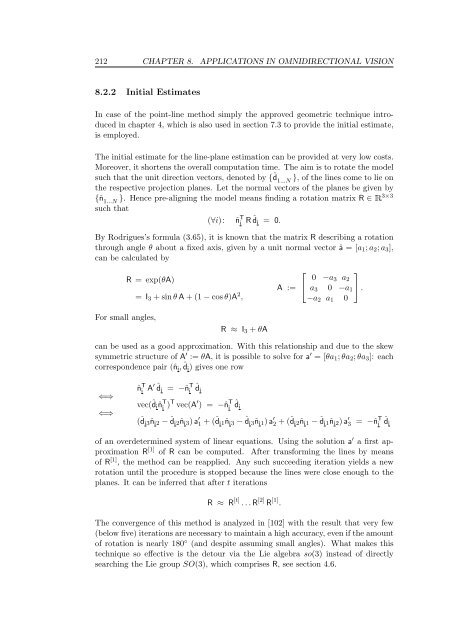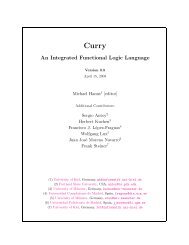Conformal Geometric Algebra in Stochastic Optimization Problems ...
Conformal Geometric Algebra in Stochastic Optimization Problems ...
Conformal Geometric Algebra in Stochastic Optimization Problems ...
You also want an ePaper? Increase the reach of your titles
YUMPU automatically turns print PDFs into web optimized ePapers that Google loves.
212 CHAPTER 8. APPLICATIONS IN OMNIDIRECTIONAL VISION<br />
8.2.2 Initial Estimates<br />
In case of the po<strong>in</strong>t-l<strong>in</strong>e method simply the approved geometric technique <strong>in</strong>troduced<br />
<strong>in</strong> chapter 4, which is also used <strong>in</strong> section 7.3 to provide the <strong>in</strong>itial estimate,<br />
is employed.<br />
The <strong>in</strong>itial estimate for the l<strong>in</strong>e-plane estimation can be provided at very low costs.<br />
Moreover, it shortens the overall computation time. The aim is to rotate the model<br />
such that the unit direction vectors, denoted by { ˆ d 1...N }, of the l<strong>in</strong>es come to lie on<br />
the respective projection planes. Let the normal vectors of the planes be given by<br />
{ˆn 1...N }. Hence pre-align<strong>in</strong>g the model means f<strong>in</strong>d<strong>in</strong>g a rotation matrix R ∈ � 3×3<br />
such that<br />
(∀i): ˆn T i R ˆ di = 0.<br />
By Rodrigues’s formula (3.65), it is known that the matrix R describ<strong>in</strong>g a rotation<br />
through angle θ about a fixed axis, given by a unit normal vector â = [a1;a2; a3],<br />
can be calculated by<br />
R = exp(θA)<br />
For small angles,<br />
= I3 + s<strong>in</strong>θ A + (1 − cos θ)A 2 ,<br />
R ≈ I3 + θA<br />
A :=<br />
⎡ ⎤<br />
0 −a3 a2<br />
⎣ a3 0 −a1⎦.<br />
−a2 a1 0<br />
can be used as a good approximation. With this relationship and due to the skew<br />
symmetric structure of A ′ := θA, it is possible to solve for a ′ = [θa1; θa2; θa3]: each<br />
correspondence pair (ˆni, ˆ di) gives one row<br />
⇐⇒<br />
⇐⇒<br />
ˆn T i A ′ ˆ di = −ˆn T i ˆ di<br />
vec( ˆ diˆn T i ) T vec(A ′ ) = −ˆn T i ˆ di<br />
( ˆ di3ˆni2 − ˆ di2ˆni3)a ′ 1 + ( ˆ di1ˆni3 − ˆ di3ˆni1) a ′ 2 + ( ˆ di2ˆni1 − ˆ di1ˆni2)a ′ 3 = −ˆn T i ˆ di<br />
of an overdeterm<strong>in</strong>ed system of l<strong>in</strong>ear equations. Us<strong>in</strong>g the solution a ′ a first approximation<br />
R [1] of R can be computed. After transform<strong>in</strong>g the l<strong>in</strong>es by means<br />
of R [1] , the method can be reapplied. Any such succeed<strong>in</strong>g iteration yields a new<br />
rotation until the procedure is stopped because the l<strong>in</strong>es were close enough to the<br />
planes. It can be <strong>in</strong>ferred that after t iterations<br />
R ≈ R [t] . ..R [2] R [1] .<br />
The convergence of this method is analyzed <strong>in</strong> [102] with the result that very few<br />
(below five) iterations are necessary to ma<strong>in</strong>ta<strong>in</strong> a high accuracy, even if the amount<br />
of rotation is nearly 180 ◦ (and despite assum<strong>in</strong>g small angles). What makes this<br />
technique so effective is the detour via the Lie algebra so(3) <strong>in</strong>stead of directly<br />
search<strong>in</strong>g the Lie group SO(3), which comprises R, see section 4.6.
















